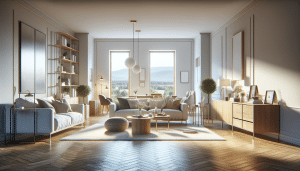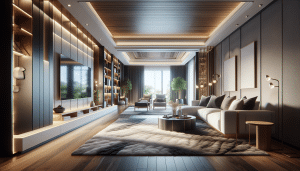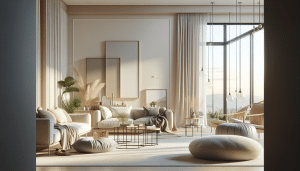You Can Transform Your Space With Minimalist Home Décor
Jessica White August 30, 2025
Curious about making life lighter and rooms brighter? Explore how minimalist home décor creates peaceful spaces, clears clutter, and brings subtle luxury to everyday living. This practical guide shares design secrets, calming color ideas, and tips for sustainable minimalism to help your lifestyle truly shine.
Rediscover Calm Through Minimalist Design
Minimalist home décor means more than fewer things—it’s a shift toward calm and clarity in daily life. This approach reduces visual clutter, so every piece has purpose. Walls are open. Flat surfaces breathe. The energy of a space changes when you let go of what’s unnecessary. Minimalist design helps create peaceful environments where relaxing feels natural and distractions fade. Many find that living with less leads to more restful sleep and lower stress levels.
At the heart of minimalist interiors is intentionality. You choose furnishings, art, and textiles for a reason, not just to fill space. It’s about bringing in light, letting natural textures shine, and keeping pathways open. In smaller homes or apartments, minimalist décor expands the sense of roominess—making compact spaces feel airy and bright. Simplicity shouldn’t feel sterile; the right approach balances comfort and practical function. Thoughtful design guides the mind toward focus and well-being, not starkness or sacrifice.
Living minimally doesn’t mean giving up style. Minimalist home décor embraces beauty through clean lines, neutral palettes, and subtle contrast. Cozy throws, natural woods, and soft lighting create warmth without chaos. The magic of minimalism often lies in the details—a single striking vase, a sleek sofa, or curated books on a slim shelf. These elements combine to craft a home that feels both luxurious and livable. Many find they enjoy their favorite possessions more when every item is chosen with care.
Color Palettes for a Softer, Brighter Home
Color transforms mood and perception in minimalist spaces. Soft whites, taupe, gentle greys, and pale wood dominate calming interiors. These hues open small rooms, reflecting light and promoting a restful ambiance. Layers of white are never boring—subtle shifts in tone, texture, and finish help keep spaces interesting while maintaining serenity. Pops of muted color—sage green, blush, or soft blue—add personality and warmth to an otherwise neutral scheme.
Designers often suggest reflecting nature’s color palette. Imagine the sand on a beach or the softness of fog rolling in. Bringing these tones inside the home mirrors the tranquility of the outdoors. Soft color schemes are known to ease mind and body, supporting concentration and quiet. Minimalism isn’t about removing all color, but about using it thoughtfully. Even a single olive throw or clay vase acts as visual punctuation in a sea of quiet tones.
Contrast—used sparingly—enlivens a minimalist room. Black window frames, dark wood floors, or charcoal textiles anchor light spaces and provide dimension. Warm neutrals paired with a single bold artwork invite conversation without overwhelming the senses. Color in minimalist décor works like background music: it should soothe and support, never shout for attention. The right combination invites you to linger and unwind, turning living areas into sanctuaries.
Declutter Smarter: Storage and Organization Strategies
Clutter accumulates quickly. Effective storage is essential in minimalist homes. Open shelving requires discipline; closed cabinets hide what’s not beautiful or necessary. Entryway benches with storage, baskets under beds, and modular cube systems keep items out of sight. The trick is to store without hoarding—discipline and regular editing are required.
Minimalist organization isn’t just about tidiness; it’s about knowing what you own and loving what stays. Decluttering starts with honest questions: When did I last use this? Does it serve a purpose or spark joy? Every six months, reevaluate rooms and storage so excess doesn’t creep in. Visual calm depends on clearing surfaces—kitchens free of appliances, desks with only essentials, living rooms open for gatherings not piled with objects.
Smart storage solutions—vertical shelving, wall hooks, folding furniture—allow for flexibility in small spaces. Technology can help too, with organizing apps or digital receipts reducing paper clutter. Design experts often recommend ‘one in, one out’ rules to maintain balance. When everything has a dedicated place, it’s easier to clean up and enjoy the room. A well-ordered space is often more relaxing and easier to use, creating time for what matters.
Choosing Minimalist Furniture and Decor Items
Minimalist furnishings are defined by simple lines, functional forms, and neutral colors. Think of a low sofa in soft grey wool, a pale oak dining table, or a single geometric pendant lamp. Furniture with hidden storage—drawers under beds, ottomans holding blankets—maximizes utility without adding visual bulk. Dual-purpose pieces are especially valuable in apartments and small homes.
Selecting décor items requires restraint and intention. Wall art should be meaningful and spare, perhaps a black-and-white photograph or a muted abstract painting. Plants add vibrancy and life, purifying the air while connecting you to nature. Textiles—linen pillows, a woven rug, a textured throw—soften crisp lines and bring warmth. Always seek quality over quantity; a single handmade vase or artisan lamp is more impactful than shelves of knickknacks.
When choosing materials, lean on durability and sustainability. Natural woods, recycled glass, organic cotton, and ceramic last for years and age beautifully. Minimalist homes are not instantly assembled, but thoughtfully evolved. Experiment with layouts—try rearranging furniture to open up traffic flow or highlight favorite pieces. This approach allows you to appreciate the craftsmanship and stories behind each object. The guiding principle: keep only what is functional, beautiful, or both.
The Benefits of Sustainable Minimalism
Minimalist decor aligns naturally with eco-friendly values. Choosing fewer, longer-lasting items reduces waste and consumption. Many people find that shopping less—and more intentionally—leads to savings and deeper satisfaction. Sustainable minimalism does not require perfection; it’s about making conscious choices over time. Donating what’s no longer needed keeps useful items circulating and supports local communities.
Eco-minimalism steers clear of fast furniture and disposable trends. Instead, timeless designs and sturdy builds are preferred. Furniture made from reclaimed wood, recycled plastics, and certified sustainable sources shows care both for home and planet. Many manufacturers now offer green certifications, making it easier to verify ethical origins.
Buying local and upcycling vintage finds add unique character and reduce environmental impact. Swapping or repurposing items encourages creativity and personal expression in minimal design. Over time, these practices foster an appreciation for craftsmanship and slow living. Many minimalists report lower stress, increased happiness, and a sense of harmony with their surroundings and values.
Cultivating a Minimalist Mindset Beyond Décor
Minimalism is a lifestyle choice extending far beyond furniture. It’s about clarity, focus, and conscious consumption. Many incorporate daily practices: mindful mornings, digital decluttering, or regular gratitude check-ins. This shift frees up mental bandwidth, making room for hobbies, relationships, and self-care. Minimalism encourages being present—enjoying music, sunlight, or a good meal without distraction.
Social minimalism is growing, too. Some focus on nurturing deeper connections rather than large gatherings or constant digital communication. Prioritizing experiences over possessions builds stronger family and friendship bonds. Even workspaces benefit: minimalist design can improve productivity, concentration, and overall well-being.
A minimalist mindset helps reset priorities and reduce anxiety. It’s liberating to shed what no longer serves and to curate life around meaning rather than quantity. There’s no one right way—every journey looks different. The key is starting small, staying flexible, and celebrating progress. Many discover that with less visual and mental noise, life’s simple joys shine brighter.
References
1. American Psychological Association. (n.d.). The powerful impact of decluttering and minimalism on mental health. Retrieved from https://www.apa.org/monitor/2021/03/decluttering-minimalism
2. U.S. Department of Energy. (n.d.). Saving energy through minimalist interior design choices. Retrieved from https://www.energy.gov/energysaver/saving-energy-through-minimalist-interiors
3. Environmental Protection Agency. (n.d.). Sustainable furniture and indoor air quality. Retrieved from https://www.epa.gov/indoor-air-quality-iaq/iaq-building-education-and-assessment-model
4. Harvard Health Publishing. (n.d.). Strategies for managing clutter and stress. Retrieved from https://www.health.harvard.edu/staying-healthy/managing-clutter-and-stress
5. U.S. General Services Administration. (n.d.). Sustainable purchasing for home furnishings. Retrieved from https://www.gsa.gov/buying-selling/products-services/environmentally-preferable-products-services/furniture
6. The Spruce. (n.d.). Minimalist decorating guide: tips and ideas. Retrieved from https://www.thespruce.com/minimalist-decorating-ideas-4177932








